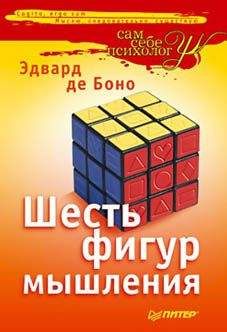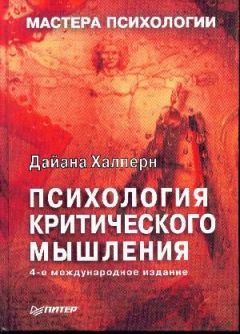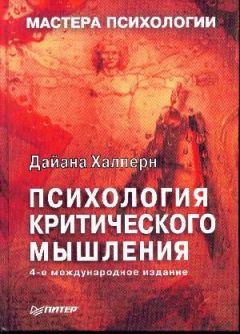Дайана Халперн - Психология критического мышления

Помощь проекту
Психология критического мышления читать книгу онлайн
Goleman D., Kaufman P., Ray M. (1993). The creative spirit. New York: Penguin.
Gordon W. J. J. (1961). Synectics. New York: Harper Row.
Gordon W. J. J. (1976). Metaphor and invention. In A. Rothenberg С R. Hausman (Eds.), The creativity Question. Durham, NC: Duke University Press.
Govier T. (1985). A practical study of argument. Bel-mont, CA: Wadsworth.
Gray W. (1991). Thinking critically about new age ideas. Belmont. CA: Wadsworth.
Greeno J. G. (1973). The structure of memory and the process of solving problems. In R. L. Solso (Ed.), Contemporary issues in cognitive psychology. Washington DC: Winston.
Greeno J. G. (1992). Mathematical and scientific thinking in classrooms and other situations. In D. F, Halp-ern (Ed.), Enhancing thinking skills in the sciences and mathematics (pp. 39–62). Hillsdale, NJ: Lawrence Erlbaum Associates.
Griffiths D.HAl976). Physics teaching: Does it hinder intellectual development? American Journal of Physics, 44, 81–85.
Gruneberg M., Morris P. (Eds.), (1992). Aspects of memory; The practical aspects. (Vol. 1) 2nd. ed. New York: Routledge.
Cuilford J. P. (1977). Way beyond the IQ. Buffalo, NY: Creative Education Foundation.
Gunther M. (1977). The luck factor. New York: Mac-millan. Hadamard, J. (1954). The psychology of invention in the mathematical field. Princeton, NJ: Princeton University Press.
Hains A. A., Hains A. H. (1987). The effects of a cognitive strategy intervention on the problem solving abilities of delinquent youths. Journal of Adolescence, 10,399–413.
Halpern D. F. (1985). The influence of sex role stereotypes on prose recall. Sex Roles, 12, 363–375.
Halpern D. F. (1987a). Analogies as a critical thinking skill. In D. Berger, K. Peydek, W. Banks (Eds.), Applications of cognitive psychology: Computing and education (pp. 75–86). Hillsdale, NJ: Lawrence Erlbaum Associates.
Halpern D. F. (1987b). Thinking across the disciplines: Methods and strategies to promote higher.order thinking in every classroom. In M. Heiman J. Slomianko (Eds.), Thinking skills instruction: Concepts and techniques (pp. 69–76). Washington, DC; National Education Association.
Halpern D. F. (1992). Sex differences in cognitive abilities (2nd ed.). Hillsdale, NJ: Lawrence Erlbaum Associates.
Halpern D. F. (Ed.). (1994). Changing college classrooms: New teaching and learnng strategies for an increasingly complex world. San Francisco: Jossey-Bass.
Halpern D. F. (in press). The skewed logic of The Bell Curve. Skeptic.
Halpern D. F., Blackman S. (1985). Magazines vs. physicians. The influence of information source on intentions to use oral contraceptives. Women and Health, 10, 9-23.
Halpern D. F., Blackman S., Salzman B. (1989). Using statistical risk information to assess oral contraceptive safety. Applied Cognitive Psychology, 3,251–260.
Halpern D. E, Hansen C, Riefer D. (1990). Analogies as an aid to comprehension and memory. Journal of Educational Psychology, 82, 298–305.
Halpern D. F., Irwin F. W. (1973). Selection of hypotheses as affected by their preference values. Journal of Experimental Psychology, 101, 105–108.
Halpern D. E., Nummedal S. G. (Eds.). (1995). Psychologists teach critical thinking [Special Issue]. Teaching of Psychology, 22. Hanson N. R. (1958). Patterns of discovery. Cambridge, England: Cambridge University Press.
Harman G. (1986). Change in view: Principles of reasoning. Cambridge, MA: MIT Press. Harris R. J. (1977). Comprehension and pragmatic implications in advertising. Journal of Applied Psychology, 62, 603–608.
Harris S. B. (1993). The resurrection myth in religion, science, and science fiction. Skeptic, 2, 50–59.
Hasher L., Zacks R. T. (1984). Automatic processing of fundamental information. American Psychologist, 39,1372–1388.
Hayes J. R. (1978). Cognitive psychology. Homewood, IL: Dorsey.
Hayes J. R. (1982). Issues in protocol analysis. In G. R. Ungson D. N. Braunstein (Eds.), Decision making: An interdisciplinary approach. Boston: Kent. Hayes J. R. (1989). Cognitive processes in creativity. In J A. Glover, R. R. Ronning, С R. Reynolds (Eds.), Handbook of creativity (pp. 135–145). New York: Plenum.
Heiman M., Slomianko J. (1986). Critical thinking skills. Washington, DC: National Education Association.
Heller /?., Sattzstein H. D., Caspe W. (1992). Heuristics in medical and non-medical decision-making. The Quarterly Journal of Experimental Psychology, pp. 211–235. HenleM. (1962). On the relation between logic and thinking. Psychological Review, 69, 366–378.
Hennessey B. A., Amabile Т. М. (1987). Creativity and learning. Washington, DC: National Education Association.
Hennessey B. A., Amabile T.M.(988). The conditions of creativity. In R. J. Sternberg (Ed.), The nature of creativity: Contemporary psychological perspectives (pp. 11–38). Cambridge, MA: Cambridge University Press. Herrmann D. J. (1991). Super memory. Emmaus, PA: Rodale.
Herrmann D. J., Weingartner H., Searleman A., McE-voy C. L. (Eds.). (1992). Memory improvement: Implications/or memory theory. New York: Spring-er-Verlag.
Herrnstein R. J., Murray C. (1994). The bell curve: Intelligence and class structure in American life. New York; The Free Press.
Herrnstein R. J., Nickerson R. S., Sanchez M., Swets J. A. (1986). Teaching thinking skills. American Psychologist, 41, 1279–1289.
Hill P., Bedau H., Checile R., Crochetiere W., Keller-man В., Dunjian D., Pauker S., Rubin J. (1979). Making decisions: A multidisciplinary introduction. Reading, MA: Addison-Wesley.
Hitchcock D. (1983). Critical thinking: A guide to evaluating information. Toronto: Methuen.
Hogarth R. M. (1988). Judgment and choice: The psychology of decision (2nd ed.). Chichester, England: Wiley.
Holland J. H., Holy oak K. J., Nisbett R. ?., Thagard P. R. (1986). Induction: Processes of inference, learning, and discovery. Cambridge, MA: MIT Press.
Holley C. D., Dansereau D. F. (1984). Networking: The technique and the empirical evidence. In C. D. Holley D. F. Dansereau (Eds.), Spatial learning strategies: Techniques, applications, and related issues (pp. 81-108). New York: Academic Press.
Holley C. D., Dansereau D. F., McDonald B. A., Garland J. D., Collins K. W. (1979). Evaluation of a hierarchical mapping technique as an aid to prose processing. Contemporary Educational Psychology, 4, 227–237.
Holt J. (1964). How children fail. New York: Dell.
Holt J. (1989). Learning all the time. Reading, MA: Addison-Wesley.
Hostetler A. J. (1988, January). Army eyes novel learning methods. The American Psychological Association Monitor, 19, 7.
Huff D. (1954). How to lie with statistics. New York: Norton.
Hunt E. (1989). Cognitive science: Definition, status, and questions. In M. R. Rosenzweig L. W. Porter (Eds.), Annual review of psychology, 40,603–630.
Hunt M. (1982). The universe within. A new science explores the human mind. New York: Simon: Schustec.
Hutchings P. (1986). Some late night thoughts on teaching creativity. American Association for Higher Educawn, 39, 9-14.
Izawa С (1993). Efficient learning: The total time, exposure duration, frequency, and programming of the study phase. In С Izawa (Ed.), Cognitive psychology applied (pp. 43–78). Hillsdale, NJ: Lawrence Erlbaum Associates.
Izawa C, Hayden R. G. (1993). Race against time: Toward the principle of optimization in learning and retention. In C. Izawa (Ed.), Cognitive psychology applied (pp. 15–42). Hillsdale, NJ: Lawrence Erlbaum Associates.
Jacoby L. L., Kelley С. М., Dywan, J. (1989). Memory attributions. In H. L. Roedinger F. I M. Craik (Eds.), Varietes of memory and consciousness: Essays in honor of Endel Tulving (pp. 391–422). Hillsdale, NJ: Lawrence Erlbaum Associates.
James W. (1890). The principles of psychology New York: Holt.
Janis I. L. (1989). Crucial decisions: Leadership in policy making and crisis management. New York: The Free Press.
Janis I. L., Mann L. (1977). Decision making: A psychological analysis of conflict, choice and commitment. New York: The Free Press.
Jason G. (1987). Are fallacies common? A look at two debates. Informal Logic, 8, 81–92.
Jensen A. R. (1980). Bias in mental testing. New York: The Free Press.
Jensen A. R. (1981). Straight talk about mental tests. New York: The Free Press.
Johnson M. K., Raye C. L. (1981). Reality monitoring. Psychological Review, 88,67–85.
Johnson-Laird P. N… Byrric R. M. J. (1991). Deduction. Hillsdale, NJ: Lawrence Erlbaum Associates.
Johnson-Laird P. N… Legrenzi P., Legrenzi M. (1972). Reasoning and a sense of reality. British Journal of Psychology. 63, 395–400.
Johnson-Laird P. N., Wason P. C. (1970). A theoretical analysis of insight into a reasoning task. Cognitive Psychology, 1, 134–148.
Johnson-Laird P. N., Wason P. С (Eds). (1977). Thinking Readings in cognitive science. Cambridge, England: Cambridge University Press.
Kahane H. (1980). Logic and contemporary rhetoric: The use of reason in everyday life (2nd ed.). Bel-mont, CA: Wadsworth.
Kahane H. (1992). Logic and contemporary rhetoric: The use of reason in everyday life (6th ed.). Bel-mont, CA: Wadsworth.
Kahneman D., Tver sky A. (1973). On the psychology of prediction. Psychological Review, 80, 237–251.
Kahneman D., Tversky A. (1979). Prospect theory: An analysis of decision under risk. Econometrica, 47, 263–291.
Kamin L. J. (1974). The science and politics of IQ. New York: Wiley.
Kavanaugh D. J., Bower G. H. (1985). Mood and self-efficacy: Impact of joy and sadness on perceived capabilities. Cognitive Therapy Research, 9, 507–525.
Kelley D. (1988). The art of reasoning. New York: Norton.
Kellogg R. T. (1990, Fall). Effectiveness of prewriting strategies as a function of task demands. American Journal of Psychology, pp. 327–342.
Kidd V. (1991, Fall). An analysis of the California tobacco education campaign's visual anti-smoking messages. Feedback, 32,14–18.
Kimble G. A. (1978). How to use (and misuse) statistics. Englewood Cliffs, NJ: Prentice-Hall.
King A. (1989). Effects of self-questioning training on college students' comprehension of lectures. Contemporary Educational Psychology, 14, 1-16.
King A. (1992). Facilitating elaborative learning through guided student-generated questioning. Educational Psychologist, pp. 111–126.
King A. (1994). Inquiry as a tool in critical thinking. In D. F. Halpern (Ed.), Changing college classrooms: New teaching and learning strategies in an increasingly complex world (pp. 13–38). San Francisco: Jossey-Bass.
King A. (1995). Inquiring minds really do want to know: Using questioning to teach critical thinking. In D. F. Halpern S. G. Nummedal (Eds.), Psychologists teach critical thinking [Special issue]. Teaching of Psychology, 22,13–17.
Klaczynski P. A. (1993). Reasoning schema effects on adolescent rule acquisition and transfer. Journal of Educational Psychology, 85, 679–692.
Klein G. A., Weizenfeld J. (1978). Improvement of skills for solving ill-defined problems. Educational Psychologist, 13, 31–41.
Kneller G. F. (1965). The art and science of creativity. New York: Holt, Rinehart Winston.
Knight K., Dansereau D. F. (1992). Tools for drug and alcohol education: Using decision worksheets in personal problem solving. Journal of Drug Education, 22(3), 261–271.
Koestler A. (1964). The act of creation. London: Hutch-inson.
Kohl H. (1981). A book of puzzlements: Play and invention with language. New York: Schocken Books.
Kohler W. (1925). The mentality of apes. New York: Harcourt, Brace.
Kohler W. (1969). The task of Gestalt psychology. Princeton, NJ: Princeton University Press.
Koriat A., Lihtenstein S., Fischhoff B. (1980). Reasons for confidence. Journal of Experimental Psychology. Human Learning and Memory, 6,107–118.
Kruglanski A. W. (1992). On methods of good judgment and good methods of judgment: Political decisions and the art of the possible. Political Psychology, 13,455–475.
Kuhn D. (1993, January). Connecting scientific and informal reasoning. Merrill-Palmer Quarterly, pp. 74-103.
Kuhn D., Weinstock M., Flaton R. (1994). How well do jurors reason? Competence dimensions of individual variation in a juror reasoning task. Psychological Science, 5, 289-296
Kunda Z., Nisbett R. E. (1986). The psychometrics of everyday life. Cognitive Psychology, 18,195–224.
LangerE. J. (1989). Mindfulness. Reading, MA: Addison-Wesley

























